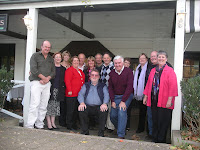A convict ship alight in Sydney Harbour in 2009!
On this coming weekend on Friday/Saturday/Sunday nights, the
Fire Water spectacular, which is part of the Vivid Sydney program will re-enact such an event from Sydney's colonial past.
Directed by Michael Cohen,
Fire Water centres on the story of the convict ship the
Three Bees.The
Three Bees arrived in Sydney Cove on 6 May 1814 with a cargo of 210 male convicts. Two weeks later on Friday 20 May, a fire broke out and quickly engulfed the ship. It was cut lose from its moorings and drifted into the Harbour. When flames reached the cannons, cannonballs shot from the ship with one reaching the office of Captain John Piper at the Naval Office in George Street and destroying his writing desk. When the ship's gunpowder stores exploded, the
Three Bees sank off Bennelong Point.
Governor Macquarie's report of the incident can be found in the following despatch to Earl Bathurst , dated 24 May 1814 [
Historical Records of Australia , Volume 8]"The transport ship, Three Bees, commanded by Captain John Wallis, arrived on 6/5/1814, with 210 male convicts; out of the 219 originally embarked, the other 9 having died on the passage; and out of those landed, it has been necessary to send 55 to the Hospital, many of them being much affected with scurvy and others labouring under various complaints.
On enquiring into the cause of this mortality and sickness, it appeared that many of them had been embarked in a bad state of health, and not a few infirm from lameness and old age. I am happy in being enabled to state that the convicts arrived by the Three Bees have, without a single exception, borne grateful testimony to their having been treated with the most unremitting care, attention and kindness, by the Master and Surgeon of the vessel, from the day of their embarkation until they were finally landed here.
A Detachment of four Subaltern Officers and 38 Soldiers of the 46th Regiment arrived by the Three Bees, having acted as a guard over the male convicts on board, and by this vessel, John Palmer, Esq., arrived with the appointment of Assistant Commissary General.
A most unfortunate accident took place in Sydney Cove immediately in front of, and at a very short distance from Government house on Friday evening last. At about 5 o’clock in the evening the fine new ship Three Bees was discovered to be on fire, and so rapid and violent was the burst of flames when the hatches were accidently raised, that all effort at extinguishing them was rendered totally useless, and must have been attended with the utmost risk to those who should have attempted it.
The danger arising from the ordinary effect of fire being increased beyond all calculation by the consideration that a very large quantity of gunpowder was deposited immediately adjoining the place from whence the flames first proceeded. No alternative was left to the Ship’s Company but to immediately abandonment, which fortunately took place without any accident whatever. At this crisis, little short of the total destruction of the Town of Sydney was expected every moment to take place by the explosion of the Magazine.
The alarm was so great that numbers of the inhabitants deserted their houses, and fled into the Country to avoid being buried in ruins, Fourteen guns, some loaded with Ball and some with Grape Shot, exploded, sending their contents in various directions, as the ship drifted through the Town, fortunately, however, without doing any damage further than the breaking a window in the Naval Officer’s House and shattering a writing desk that lay within it. At this time a light breeze blowing off the shore, and the cable being cut, the vessel drifted to the extremity of the Cove where she struck on some projecting rocks called Bennelong’s Point, and here the expected explosion took place.
Owing to some circumstance, which cannot be otherwise accounted for than by supposing that the ship had previously taken in water, and wetted the powder, the explosion did not occur till nearly two hours after it was expected, and was not by any means so tremendous as there was reason to suppose it would have been.
The alarm for the town and the shipping in the Cove was now at an end, but the fire did not cease its ravages until the fine ship was burnt down to the water’s edge, which took place in about six hours from the first discovery.
This unfortunate accident is attributed to some carelessness on the part of a Tailor, who had charge of a lighted candle in the morning in that part of the Hold whence the flames proceeded, and who is supposed to have put it out in a careless manner, dropping some of the snuff of it in an unextinguished state at his feet".
Do you have a convict ancestor who came to Sydney Cove on the Three Bees? Would you like further information?
History Services NSW has records on the entire 210 convicts who were landed ashore. Go to the website at:
http://www.historyservices.com.au/convicts.htm
 On the rainy Monday morning of 28 December 2009, Mary and I attended the commemoration of the 200th Anninversary of the arrival of Colonel Lachlan Macquarie, Governor Designate of New South Wales at the entrance to Sydney Harbour.
On the rainy Monday morning of 28 December 2009, Mary and I attended the commemoration of the 200th Anninversary of the arrival of Colonel Lachlan Macquarie, Governor Designate of New South Wales at the entrance to Sydney Harbour.




































